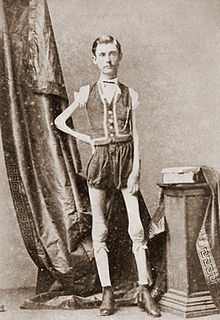
Isaac W. Sprague (May 21, 1841 – January 5, 1887) was an entertainer and sideshow performer, billed as the living human skeleton.
Biography
He was born on May 21, 1841, in East Bridgewater, Massachusetts.
Although normal for most of his childhood, Sprague began irreversibly losing weight at age 12 after feeling ill after swimming. The weight loss continued throughout his life despite having a healthy appetite. His condition has been described by historians as extreme progressive muscular atrophy. This ultimately led to his death.
Sprague bounced around from job to job during early adulthood. He worked as both a cobbler for his father and a grocer. However, his illness kept him from continuing down either of those career paths. His parents died and Sprague could not work enough to support himself, so he was left unemployed. In 1865, he was offered a job at a circus sideshow, where he became known as "the Living Skeleton" or "the Original Thin Man".
The next year P. T. Barnum, the director of the circus, hired Sprague to work at his (newly reopened and successful) American Museum Freak show. Barnum paid Sprague $80 a week (equivalent to $1,700 today) for his services. Sprague remembered the moment Barnum offered him the job: "Mr. Barnum stood very near me, and I overheard him say to his agent, 'Pretty lean man, where did you scare him up?'"
Barnum's Museum burned down in 1868 and Sprague managed to escape with his life. At this point, Sprague took time off to marry his wife, Tamar Moore. They had three sons who lived healthy, normal lives.
Sprague made attempts to stay away from the sideshow, but he could not escape financial distress. It is rumored that in addition to being financially responsible for his wife and their three sons, Sprague had a gambling problem. His condition also kept him from finding real work anywhere other than Barnum's, so he continued to tour off and on throughout the country and eventually overseas.
By the age of 44, he was 5 feet and 6 inches (168 cm) tall with a weight of only 43 pounds (19.5 kg). Sprague's condition required him to be constantly taking in nutrients. His health was in such a poor state that he often carried milk in a flask around his neck. He would sip this from time to time to keep himself up and conscious.
He died on January 5, 1887, in poverty, of asphyxia in Chicago, Illinois.
Sprague was the first of many more Living Skeleton acts to come. As a result of forced promotion and work pressure, it was not uncommon for the Living Skeleton act to marry the Fat Lady act.
Personal life
Sprague married Miss Tamar Moore shortly after 1868 and the couple had three strong, healthy, robust sons. Sprague found happiness in his family. He described his new found joy, "Life, that had at times seemed so little worth preserving, now seemed more precious."
See also
References
- ^ "Death of 'Living Skeleton'". New York Times. January 7, 1887. Retrieved 28 March 2015.
Isaac Sprague, the "living skeleton," died here yesterday. He was born in Bridgeport, Mass., and was quite healthy until his twelfth year, when he caught a cramp while in swimming, fell sick, and lost flesh until he weighed only 46 pounds. Barnum took him all over the United States, Canada, and England. He was married and the father of three robust children.
- ^ "Human Skeletons". Show History. Archived from the original on 28 September 2011. Retrieved 3 July 2023.
- ^ Bolin, Steven. "I. W. Sprague". Steven Bolin's Vintage Sideshow Photographs. Archived from the original on 27 December 2019. Retrieved 3 July 2023.
- ^ Pednaud, J Tithonus (June 29, 2016). "Isaac W. Sprague - The Original Living Skeleton". The Human Marvels. Archived from the original on 5 October 2011. Retrieved 3 July 2023.
- Cantrell, M Asher (June 28, 2016). "The True Stories Behind 11 Famous Sideshow Performers". Mental Floss. Retrieved 3 July 2023.
- ^ Hartzman, Marc (June 29, 2016). "Isaac W. Sprague, The Original Thin Man". American Sideshow. Penguin. p. 158. ISBN 9781440649912.
- 1634–1699: McCusker, J. J. (1997). How Much Is That in Real Money? A Historical Price Index for Use as a Deflator of Money Values in the Economy of the United States: Addenda et Corrigenda (PDF). American Antiquarian Society. 1700–1799: McCusker, J. J. (1992). How Much Is That in Real Money? A Historical Price Index for Use as a Deflator of Money Values in the Economy of the United States (PDF). American Antiquarian Society. 1800–present: Federal Reserve Bank of Minneapolis. "Consumer Price Index (estimate) 1800–". Retrieved February 29, 2024.
- Nickell, Joe (2005). Secrets of the Sideshows. Lexington, Ky.: University Press of Kentucky. p. 103. ISBN 0-8131-7179-2. OCLC 65377460.
External links
- "The Living Skeleton; He Agrees to Give His Body to Harvard Medical College", New York Times, December 23, 1883.